We’ve discovered the perfect fusion of Korean flavors and classic jerky that’ll transform your snack game forever. Korean beef jerky takes traditional dried meat to exciting new heights with bold marinades featuring soy sauce, sesame oil, and Korean chili flakes that create an irresistible sweet-savory balance.
Unlike store-bought versions loaded with preservatives, our homemade Korean beef jerky lets you control every ingredient while saving money. The marinade penetrates deep into thinly sliced beef, creating tender strips bursting with umami-rich flavors that’ll have you reaching for more.
Whether you’re meal prepping for busy weeks ahead or searching for the ultimate portable protein snack, this Korean-inspired jerky delivers restaurant-quality taste right from your kitchen. We’ll show you exactly how to achieve that perfect chewy texture and authentic Korean flavor profile that makes this jerky absolutely addictive.
Ingredients
Our Korean beef jerky requires just a handful of premium ingredients that work together to create that signature sweet and savory flavor profile. We’ve organized everything into two simple categories to make your prep work seamless.
For the Marinade
- 1/2 cup soy sauce (preferably low sodium)
- 1/4 cup brown sugar (packed)
- 2 tablespoons sesame oil
- 2 tablespoons rice vinegar
- 1 tablespoon gochugaru (Korean red pepper flakes)
- 1 tablespoon minced fresh ginger
- 4 cloves garlic (minced)
- 2 green onions (finely chopped)
- 1 tablespoon honey
- 1 teaspoon ground black pepper
- 1/2 teaspoon onion powder
For the Beef
- 2 pounds lean beef (eye of round or top round, trimmed of all visible fat)
- 1/4 teaspoon salt (for initial seasoning)
Equipment Needed
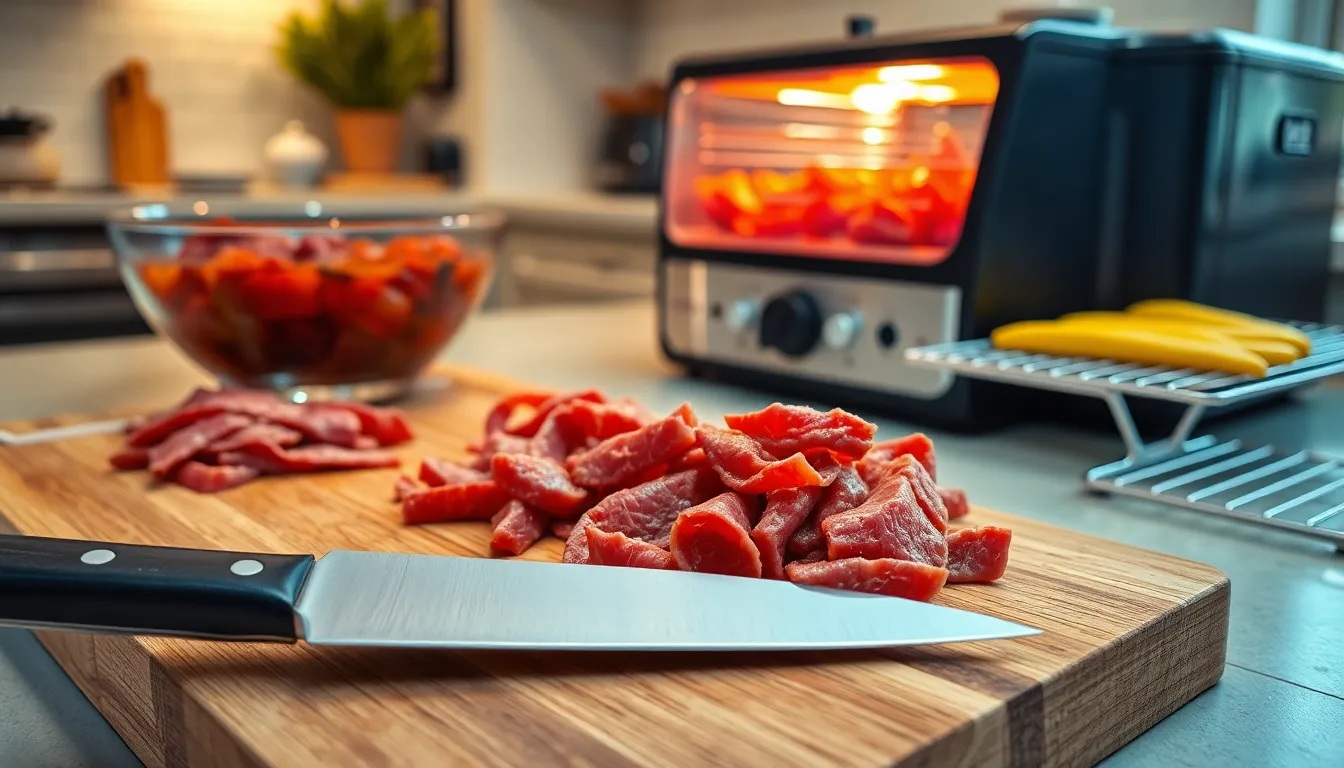
Creating authentic Korean beef jerky requires exact tools that ensure proper preparation and optimal drying results. We recommend gathering these essential items before starting our recipe to streamline the entire process.
Sharp knife stands as our most critical tool for slicing the beef into thin strips against the grain. The blade should be well-maintained to achieve consistent 1/8 to 1/4 inch thick cuts that promote even drying and tender texture.
Large mixing bowl provides adequate space for combining marinade ingredients and coating beef strips thoroughly. We prefer using a bowl that holds at least 3 to 4 quarts to accommodate the 2 pounds of beef and marinade mixture without overcrowding.
Food dehydrator offers the most reliable method for drying Korean beef jerky at consistent temperatures. Set the unit between 145°F to 165°F for optimal results during the 3 to 4 hour drying process. Alternative options include using an oven or smoker when a dedicated dehydrator is unavailable.
Baking rack or wire rack becomes necessary when using an oven or smoker instead of a food dehydrator. These racks allow proper air circulation around each beef strip for even moisture removal throughout the drying period.
Zip-top bag serves as an excellent marinating vessel that ensures every piece of beef gets thoroughly coated with our Korean-inspired marinade. The sealed environment helps flavors penetrate the meat during the several hours or overnight marinating process.
Each piece of equipment plays a exact role in transforming our marinated beef into the perfect Korean-style jerky with authentic flavors and ideal texture.
Instructions
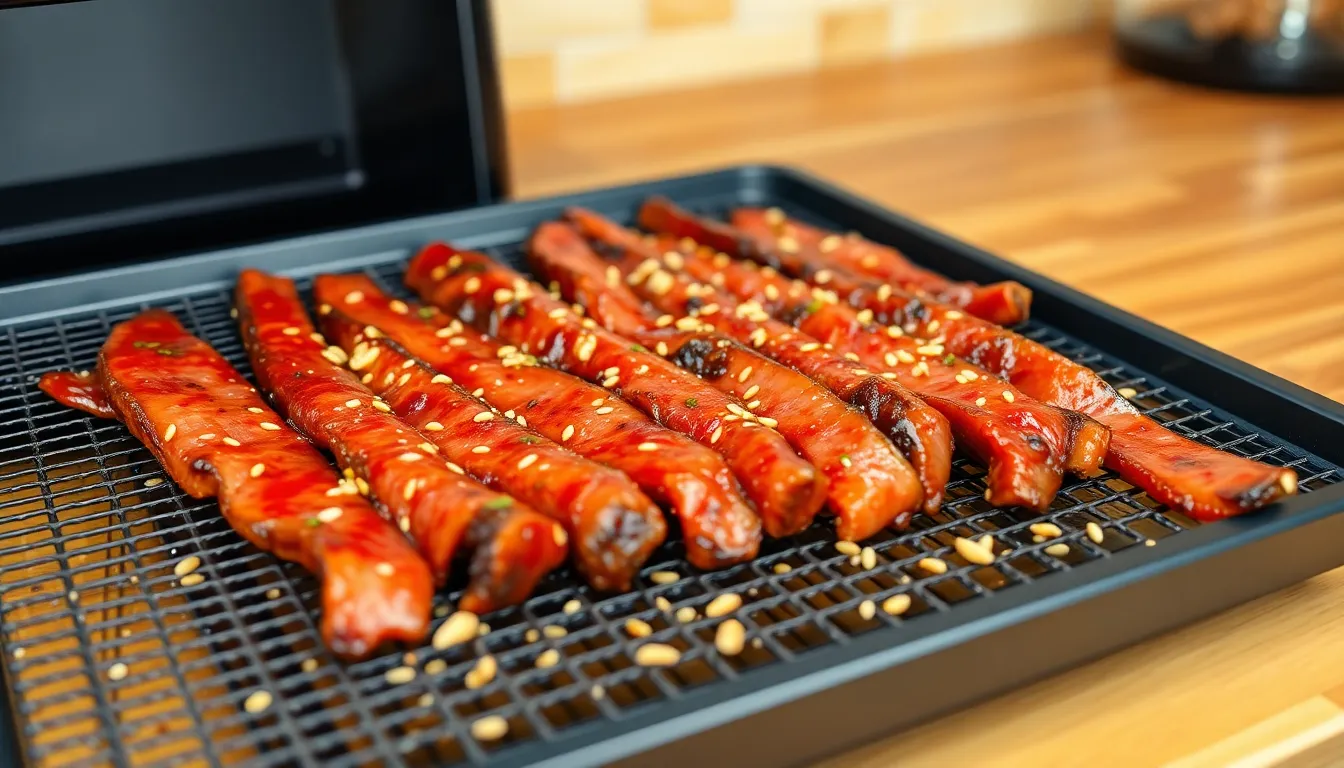
Now that we have our ingredients and equipment ready, let’s walk through the step-by-step process to create this authentic Korean beef jerky. Follow these detailed instructions to achieve the perfect balance of flavors and texture.
Prep the Beef
Start by selecting lean, flavorful beef cuts such as flank steak, top round, bottom round, or eye of round with minimal fat content. We want to avoid fattier cuts while keeping a tiny amount of fat for enhanced flavor. Place the beef in the freezer for 30 minutes to firm it up for easier slicing.
Remove the beef from the freezer and slice it thinly along the grain using your sharp knife. Cut the strips approximately ¼ inch thick for optimal texture and drying. Season the sliced beef lightly with salt and set aside while we prepare the marinade.
Make the Marinade
Combine all marinade ingredients in a large mixing bowl for authentic Korean flavor development. Add ½ cup to 1 cup soy sauce depending on the quantity of beef you’re using. Mix in 6 to 9 cloves of minced garlic for that signature Korean taste.
Incorporate ¼ cup brown sugar plus 1 tablespoon honey to create the perfect sweet balance. Add 1 teaspoon ground black pepper and 2 teaspoons liquid smoke for added depth. Sprinkle in 2 tablespoons toasted sesame seeds for nutty flavor and texture.
Enhance the marinade with 2 tablespoons rice wine, 1 teaspoon sesame oil, and ½ teaspoon ground ginger. For those who enjoy heat, add crushed chili flakes to taste. Whisk all ingredients together until the sugar completely dissolves.
Marinate the Beef
Place the sliced beef into the prepared marinade and coat each piece thoroughly. Ensure every strip is completely covered with the flavorful mixture. Transfer the beef and marinade to a zip-top bag for better coverage.
Seal the bag and massage gently to distribute the marinade evenly. Refrigerate for at least 30 minutes, though we recommend marinating for several hours or overnight to fully absorb the complex flavors. The longer marination time allows the beef to develop deeper taste and improved tenderness.
Dehydrate the Beef
Remove the marinated beef from the refrigerator and drain excess marinade. Arrange the beef slices in a single layer on your food dehydrator trays, ensuring pieces don’t overlap or touch. Leave space between strips for proper air circulation.
Set your dehydrator according to the manufacturer’s instructions, typically running for several hours until the jerky becomes dried but still pliable. Check the jerky periodically and remove pieces that finish earlier than others.
The finished Korean beef jerky should bend without breaking and feel leathery to the touch. This process yields approximately 35 to 40 pieces from 3 pounds of beef, creating a substantial batch perfect for snacking or gifting.
Dehydrator Method
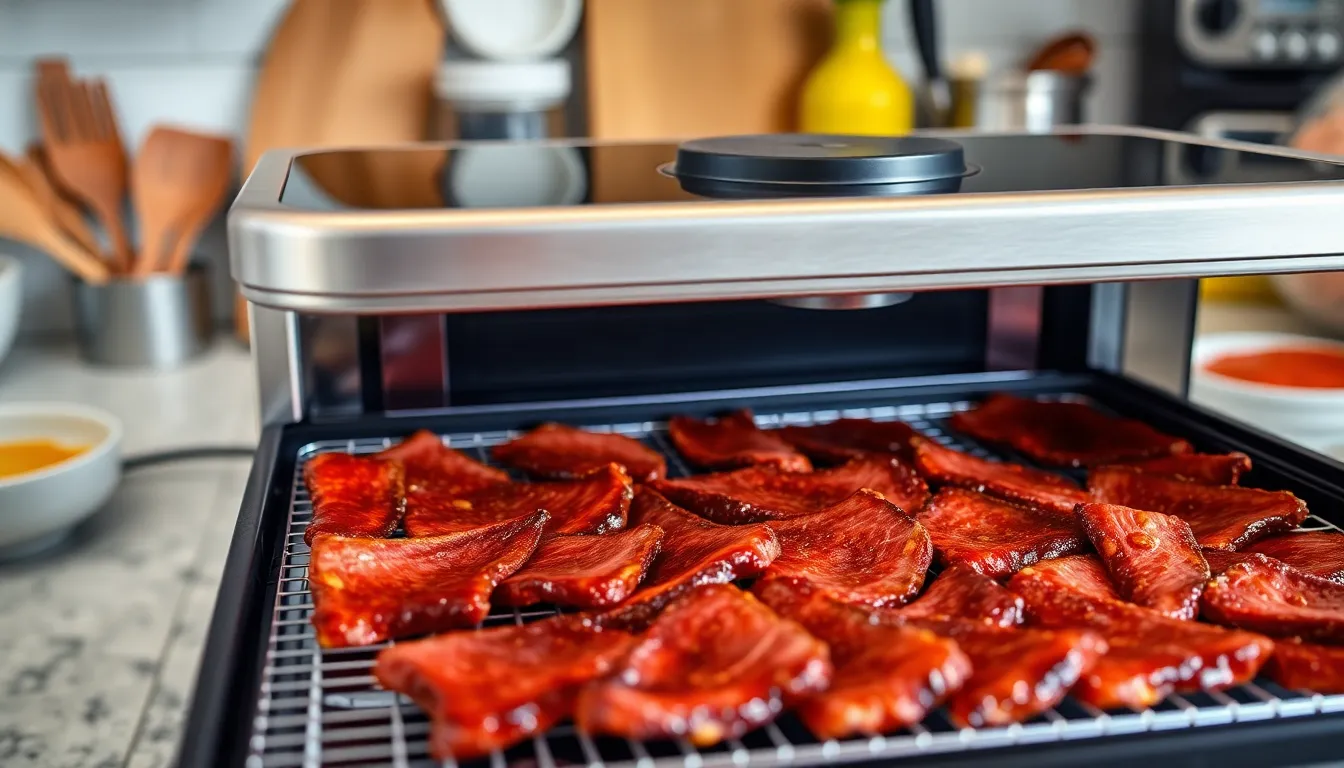
We recommend using a food dehydrator for the most consistent results when making Korean beef jerky. This method provides precise temperature control and even air circulation for optimal drying.
Temperature and Time Settings
We arrange the marinated beef slices in a single layer on dehydrator trays without overlapping pieces. Set your dehydrator to 160°F using the jerky setting for best results.
The total drying time takes approximately 8 hours following this proven approach:
| Drying Phase | Temperature | Duration | Action Required |
|---|---|---|---|
| Initial drying | 160°F | 4 hours | Arrange beef on trays |
| Mid-process check | 160°F | – | Flip pieces and rearrange trays |
| Final drying | 160°F | 4 hours | Continue until done |
| Total time | 160°F | 8 hours | Check for doneness |
We flip the jerky pieces and rearrange the trays after the first 4 hours to ensure even drying throughout. Some dehydrators may require slight temperature adjustments between 155°F and 165°F depending on your exact model.
For thinner beef slices or more powerful dehydrators we sometimes reduce the total time to 6-7 hours. Always monitor the jerky closely during the final 2 hours of drying.
Checking for Doneness
We test the jerky’s readiness by removing a piece and allowing it to cool for a few minutes. Properly dried Korean beef jerky should feel dry to the touch while remaining slightly pliable.
The jerky passes our doneness test when it bends and develops small cracks without breaking completely in half. We avoid over-drying which creates brittle jerky that snaps easily.
If some pieces still feel moist or soft we leave them on the dehydrator trays for an additional 1-2 hours. Thicker pieces near the edges may require extra drying time compared to thinner center pieces.
We place any pieces that need additional drying on a clean tray at room temperature for 30-60 minutes if the dehydrator cycle is complete. Store the finished jerky in an airtight container at room temperature for up to one week or freeze for up to three months.
Oven Method
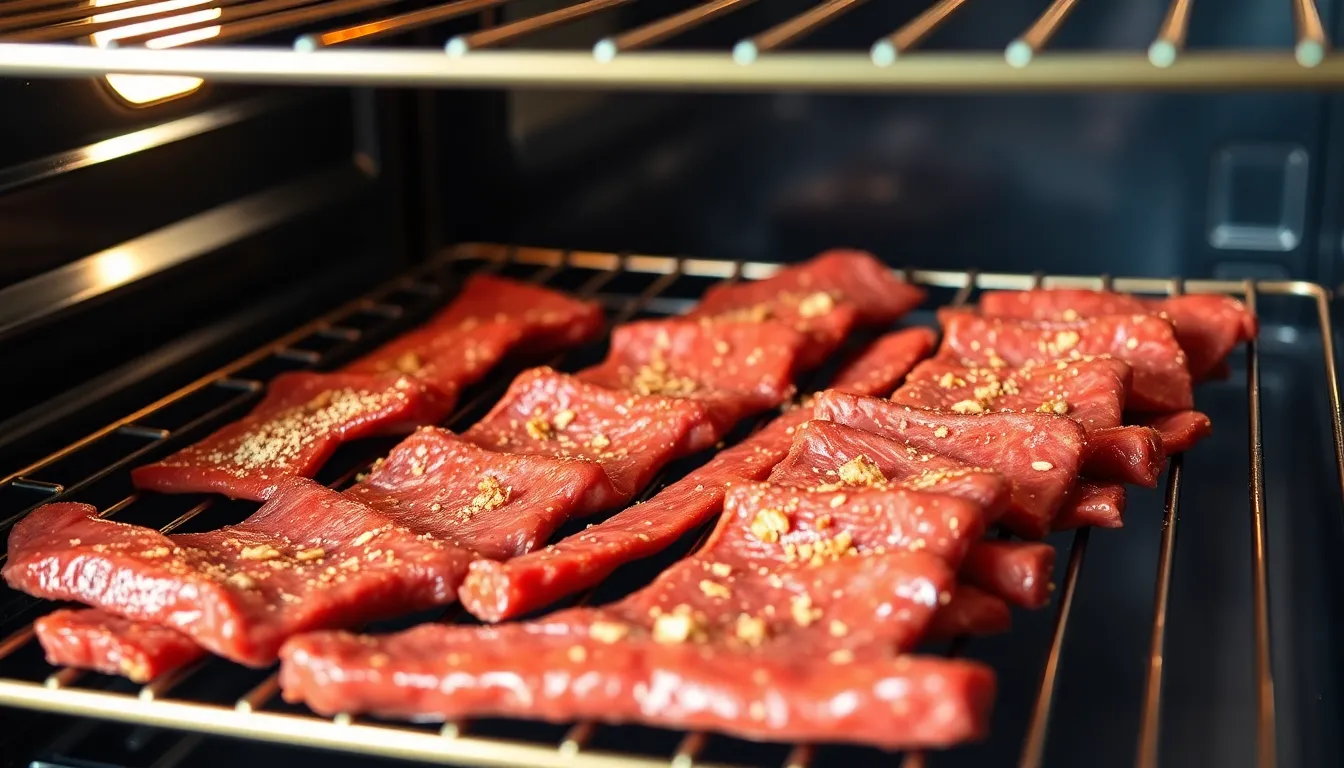
When a food dehydrator isn’t available we can achieve excellent results using our home oven with proper temperature control and monitoring. This method requires careful attention to temperature settings and regular checking to ensure even drying without overcooking our Korean beef jerky.
Temperature and Time Settings
We need to set our oven to a low temperature between 165°F to 200°F with 175°F being the optimal setting for consistent drying. The key is maintaining steady heat while allowing moisture to escape effectively.
| Temperature Setting | Drying Time | Best For |
|---|---|---|
| 165°F (74°C) | 6-8 hours | Thicker slices or maximum tenderness |
| 175°F (79°C) | 4-6 hours | Optimal balance of time and texture |
| 200°F (93°C) | 2-4 hours | Faster drying with oven door propped open |
Before placing our marinated beef in the oven we should remove excess moisture by patting each strip dry with paper towels. We arrange the beef strips in a single layer on wire racks placed over baking sheets to ensure proper air circulation around each piece. This setup prevents the jerky from sitting in its own moisture and promotes even drying throughout the process.
Rotating and Monitoring
Halfway through our estimated drying time we must flip each beef strip to ensure even moisture removal from both sides. This rotation prevents the jerky from sticking to the racks and promotes uniform texture development.
We check our jerky periodically by testing a piece for proper doneness. The finished product should feel dry to the touch but remain slightly pliable when bent. If the jerky snaps cleanly when folded it has been overdried and will lack the desired chewy texture we want in authentic Korean beef jerky.
During the drying process we monitor for any pieces that may be drying faster than others due to thickness variations or oven hot spots. We can remove individual pieces as they reach the proper consistency rather than waiting for the entire batch to finish. Any pieces that need additional drying after our initial oven time can continue air-drying at room temperature until they reach the perfect texture.
Air Fryer Method
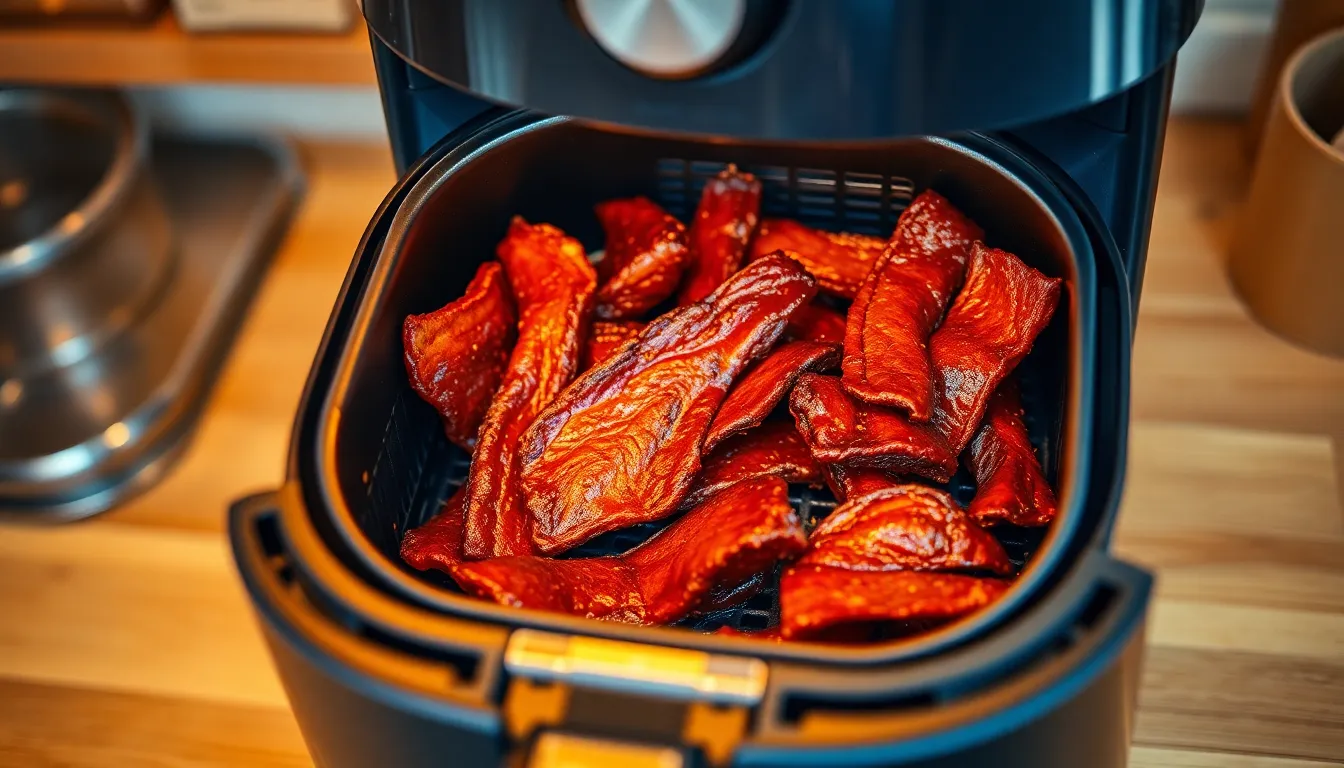
Air fryers offer a convenient alternative to traditional dehydrating methods for making Korean beef jerky. This method significantly reduces drying time while still producing tender jerky with authentic Yukpo flavors.
Temperature and Time Settings
We recommend preheating your air fryer to 160°F (71°C) for optimal results. Lower temperatures preserve the meat’s tenderness better than higher heat settings. Place the marinated beef slices in the air fryer basket ensuring they lay flat without overlapping.
Cook the jerky for approximately 3 to 4 hours depending on the thickness of your beef strips and desired dryness level. Some recipes suggest increasing the temperature to 180°F for shorter cooking times around 2 hours. But we find that the lower temperature method produces superior texture and prevents the jerky from becoming overly brittle.
| Temperature Setting | Cooking Time | Best For |
|---|---|---|
| 160°F (71°C) | 3-4 hours | Tender texture |
| 180°F (82°C) | 2 hours | Quicker results |
Flipping and Checking
Flip the beef jerky slices halfway through the cooking time to ensure even drying on both sides. This prevents burning and creates uniform texture throughout each piece. Begin checking your jerky around the 3 hour mark to assess the texture.
Properly dried Korean beef jerky should feel dry to the touch but remain slightly pliable when bent. The finished product should not crack or break when folded. Overcooking creates an undesirably brittle texture that lacks the characteristic chewiness of authentic Yukpo.
Allow the jerky to cool completely before transferring to storage containers. Store in airtight containers at room temperature for up to one week or freeze for up to three months for longer preservation.
Storage Instructions
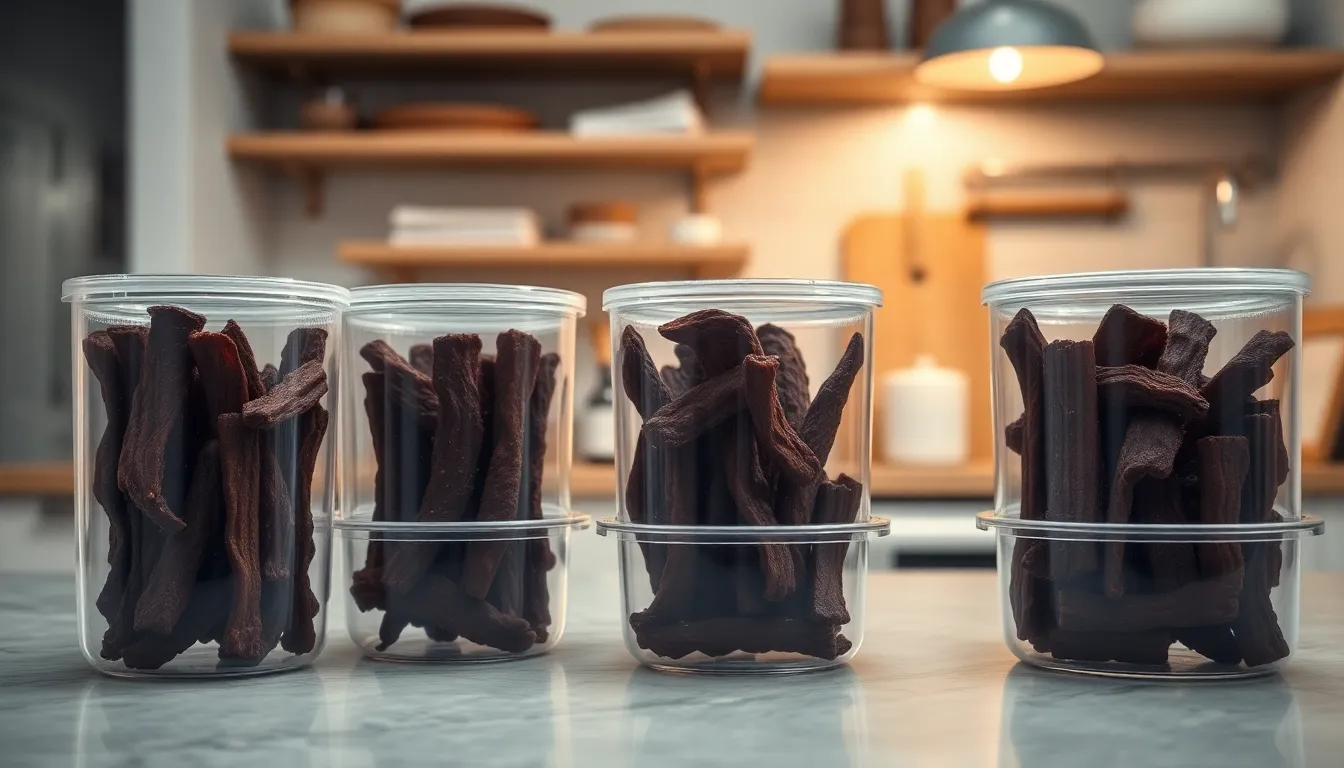
Proper storage keeps our Korean beef jerky fresh and maintains its authentic yukpo flavors for extended periods. We recommend storing the completely cooled jerky in airtight containers to prevent moisture absorption and preserve texture.
Room Temperature Storage
We can store our finished Korean beef jerky at room temperature for up to 1 week when kept in airtight containers or sealed plastic bags. The jerky must be completely dry and cooled before packaging to prevent condensation that could lead to spoilage. We always place containers away from direct sunlight and heat sources to maintain optimal quality.
Refrigerated Storage
For longer freshness we store the jerky in refrigerator conditions where it remains good for up to 2 weeks. We use airtight containers or vacuum-sealed bags to prevent the jerky from absorbing other flavors or moisture from the refrigerator environment.
Freezer Storage
Extended storage becomes possible when we freeze our Korean beef jerky in sealed containers or freezer bags for up to 3 months. We thaw frozen jerky at room temperature for 5 to 10 minutes before serving to restore its ideal chewy texture.
| Storage Method | Shelf Life |
|---|---|
| Room Temperature | 1 week |
| Refrigerator | 2 weeks |
| Freezer | 3 months |
Storage Best Practices
We ensure our jerky stays fresh by using clean utensils and containers during the storage process. Moisture represents the biggest threat to jerky quality so we always verify complete drying before storage. We keep stored jerky away from humidity and temperature fluctuations that could compromise the texture and flavor we worked to achieve.
Make-Ahead Tips
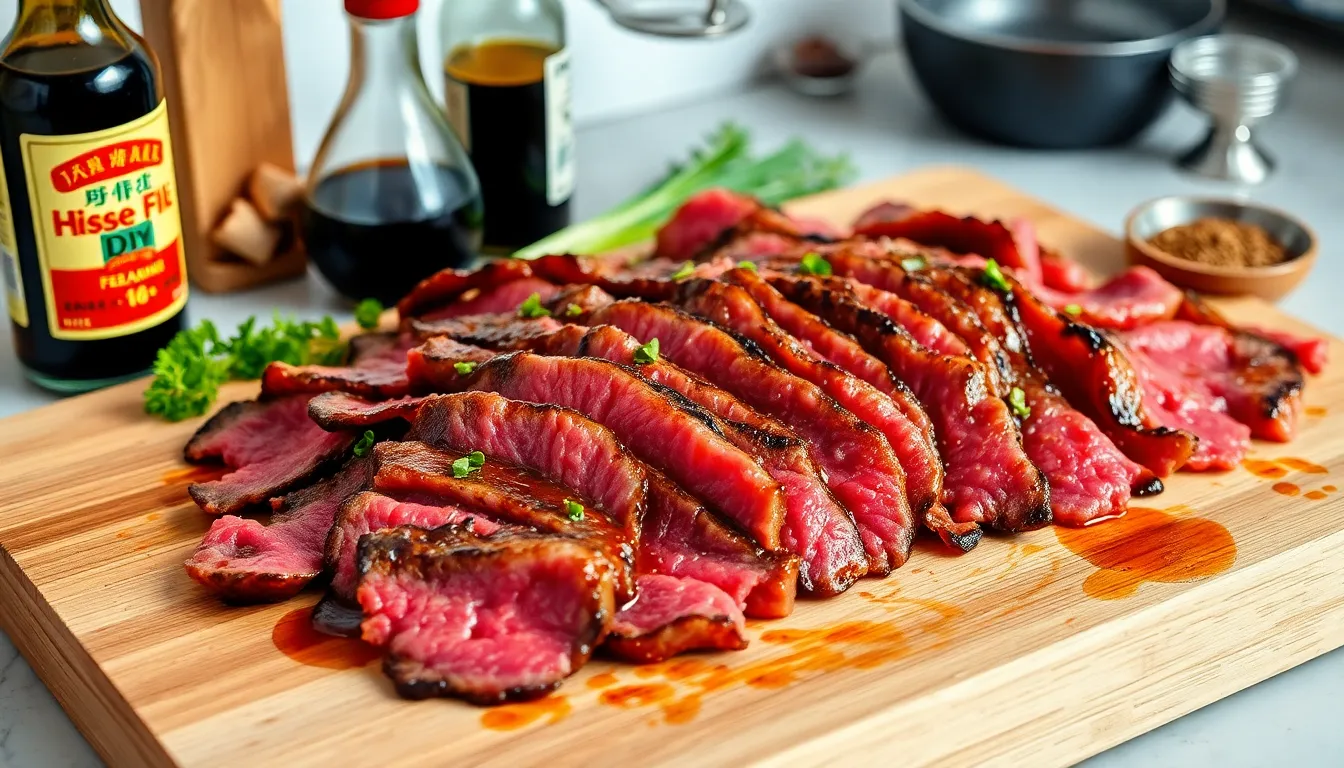
Korean beef jerky preparation benefits significantly from advance planning to develop the deepest flavors and achieve optimal texture. We recommend implementing these strategic make-ahead techniques to streamline your jerky-making process and enhance the final results.
Freezing for Precise Slicing
Partially freeze your beef for 1 to 2 hours before slicing to achieve the thinnest, most uniform cuts possible. This technique allows us to create consistent 1/8-inch to 1/4-inch thick strips that dry evenly and produce the authentic chewy texture characteristic of traditional Yukpo. The firmer texture from partial freezing prevents the meat from tearing during slicing and ensures clean edges on each piece.
Extended Marination Timeline
Plan your marination period strategically for maximum flavor penetration. We suggest marinating the beef strips for a minimum of 8 hours, though extending this process up to 2 days in the refrigerator delivers significantly deeper, more complex flavors. The longer marination allows the soy sauce, sesame oil, and aromatics to fully penetrate the meat fibers, creating layers of taste throughout each piece.
Batch Preparation Strategy
Prepare multiple batches simultaneously to make the most efficient use of your time and equipment. We recommend doubling or tripling the recipe when possible, as the active preparation time remains nearly the same while significantly increasing your yield. Store excess marinated beef in separate zip-top bags, clearly labeled with preparation dates for easy tracking.
Marinade Preparation Timeline
Create your marinade mixture 24 hours before you plan to slice the beef. This advance preparation allows the brown sugar to fully dissolve and the flavors to meld together, creating a more harmonious taste profile. Store the prepared marinade in the refrigerator until ready to use with your sliced beef.
Dehydrator Organization
Clean and organize your dehydrator trays the day before beginning the drying process. We suggest having backup trays ready if processing large batches, as this prevents delays during the active preparation phase. Pre-positioning your equipment ensures smooth transitions between marination and drying stages.
Storage Container Preparation
Sterilize your storage containers and have them completely dry before the jerky finishes processing. This preparation step prevents any moisture contamination that could compromise the shelf life of your finished Korean beef jerky. We recommend having multiple smaller containers ready rather than one large container to minimize exposure when accessing portions.
Serving Suggestions
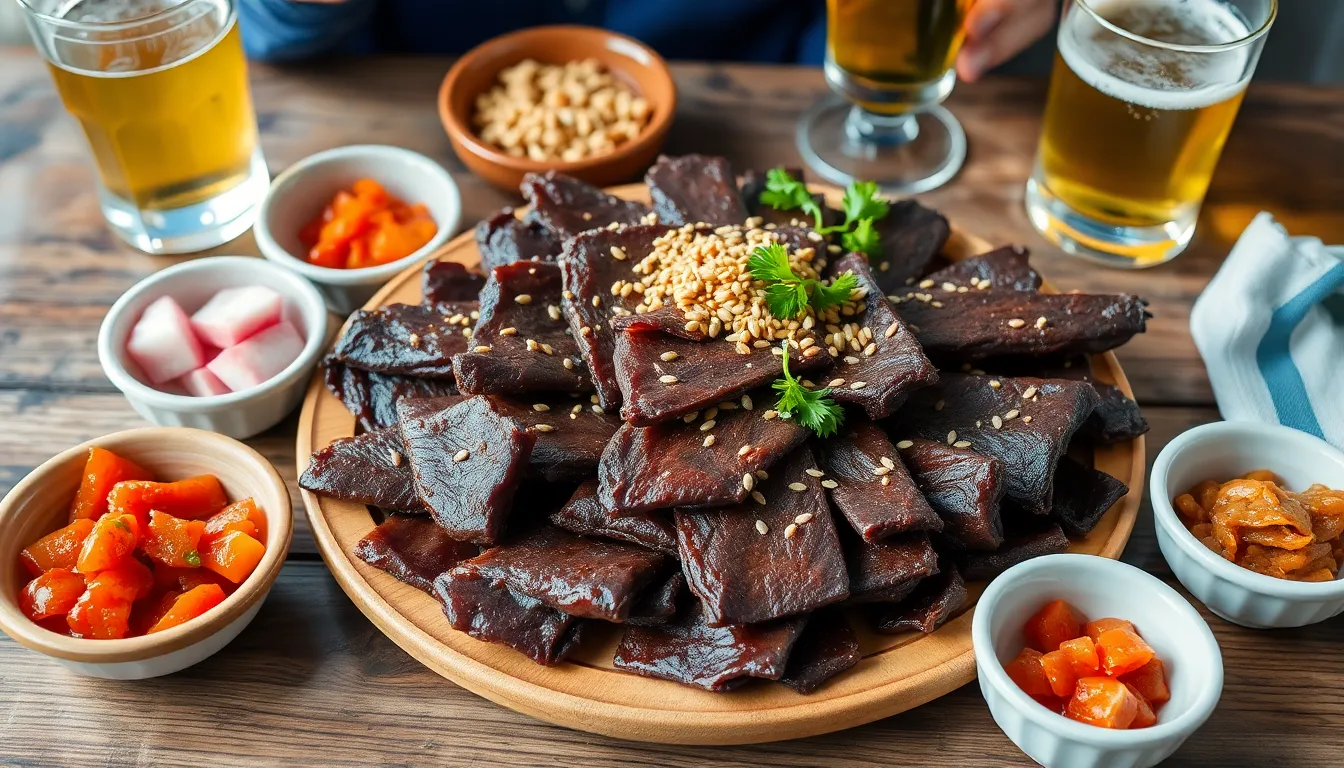
Our homemade Korean beef jerky transforms into the perfect appetizer when paired with traditional Korean beverages like soju or beer. The savory umami flavors complement alcoholic drinks beautifully while the chewy texture provides satisfying contrast to liquid refreshments.
We recommend garnishing each serving with extra toasted sesame seeds to enhance the nutty flavor profile that defines authentic Yukpo. A side of pickled radish or fresh kimchi balances the rich saltiness of the jerky while adding refreshing acidity that cleanses the palate between bites.
The versatility of our Korean beef jerky extends beyond simple snacking. We love shredding pieces into salads where the concentrated umami flavors elevate fresh greens into a protein-packed meal. Stir-fries benefit tremendously from adding torn jerky pieces during the final cooking stages to infuse dishes with deep savory notes.
Gift-giving becomes meaningful when we package our homemade jerky in decorative containers. The cultural significance of Yukpo as a traditional wedding gift makes our homemade version particularly special for celebrating important occasions with family and friends.
| Serving Context | Recommended Pairings | Portion Size |
|---|---|---|
| Appetizer | Soju or beer | 2-3 pieces per person |
| Snack | Pickled vegetables | 4-5 pieces |
| Salad topping | Mixed greens | 1-2 shredded pieces |
| Gift presentation | Decorative container | 6-8 pieces |
We suggest storing opened jerky in small portions to maintain freshness while serving. Room temperature presentation works best as it allows the full flavor profile to emerge while maintaining the ideal chewy texture that makes Korean beef jerky so distinctive.
Conclusion
We’ve shared everything you need to create authentic Korean beef jerky that rivals any store-bought version. This homemade approach gives you complete control over ingredients while delivering that perfect sweet-savory balance we all crave.
Whether you choose the dehydrator oven or air fryer method each technique produces tender flavorful jerky that’s ideal for snacking meal prep or gifting. The key lies in proper preparation from selecting the right cut to achieving that signature chewy texture.
Now it’s time to gather your ingredients and start marinating. We’re confident this recipe will become your go-to method for creating delicious Korean-style jerky that captures the authentic flavors of traditional Yukpo right in your own kitchen.
Frequently Asked Questions
What is Korean beef jerky and how is it different from regular jerky?
Korean beef jerky, known as Yukpo, features a unique marinade with soy sauce, sesame oil, gochugaru (Korean chili flakes), and other Korean ingredients. Unlike regular jerky, it offers a distinctive sweet-savory balance with umami-rich flavors and a tender, chewy texture that’s achieved through traditional Korean preparation methods.
What type of beef is best for making Korean beef jerky?
Lean cuts like eye of round, top round, or flank steak work best for Korean beef jerky. These cuts have minimal fat content and provide the ideal texture when dried. Remove all visible fat before slicing, as fat can cause spoilage and prevent proper drying.
How long should I marinate the beef for Korean jerky?
Marinate the beef for a minimum of 30 minutes, but for best results, marinate for at least 8 hours or up to 2 days. Longer marination allows the Korean flavors to penetrate deeper into the meat, resulting in more authentic and flavorful jerky.
Can I make Korean beef jerky without a food dehydrator?
Yes, you can use a home oven set to 165-200°F (175°F is optimal) or an air fryer at 160°F. Oven drying takes similar time to dehydrators, while air fryers significantly reduce drying time to 3-4 hours. Both methods require proper air circulation and periodic checking.
How do I know when the Korean beef jerky is properly dried?
Properly dried jerky should feel dry to the touch but remain slightly pliable and chewy. It should bend without breaking or cracking. If the jerky feels wet or sticky, continue drying. The texture should be leathery but not brittle when finished.
How should I store homemade Korean beef jerky?
Store completely cooled jerky in airtight containers. It keeps for up to one week at room temperature, two weeks refrigerated, or up to three months frozen. Ensure the jerky is completely dry before storage and use clean utensils to prevent moisture contamination.
How many pieces of jerky will I get from 3 pounds of beef?
Approximately 35-40 pieces of jerky can be made from 3 pounds of lean beef. The exact yield depends on how thinly you slice the meat and the specific cut used. Thinner slices will dry faster and provide more pieces per pound.
What Korean ingredients are essential for authentic flavor?
Key Korean ingredients include low-sodium soy sauce, gochugaru (Korean chili flakes), sesame oil, rice vinegar, fresh ginger, and garlic. These create the signature sweet-savory balance and umami-rich flavor profile that distinguishes Korean beef jerky from other varieties.
Can I make Korean beef jerky ahead of time?
Yes, Korean beef jerky is perfect for meal prep. You can partially freeze beef for easier slicing, prepare the marinade 24 hours in advance, and marinate the beef up to 2 days ahead. The finished jerky stores well, making it ideal for batch preparation.
What are some serving suggestions for Korean beef jerky?
Serve Korean beef jerky at room temperature, garnished with toasted sesame seeds. It pairs excellently with soju or beer, can be shredded into salads, or added to stir-fries. It also makes a meaningful gift when packaged in decorative containers, honoring the cultural significance of Yukpo.







